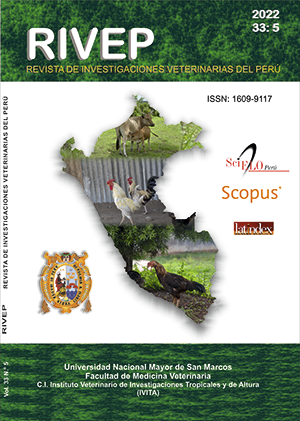Detection of antimicrobial resistance genes in isolates of Escherichia coli from production pigs with diarrheal diseases
DOI:
https://doi.org/10.15381/rivep.v33i5.23795Keywords:
Escherichia coli, pig, antimicrobial resistance, resistance genesAbstract
The aim of this study was to detect antibiotic resistance genes in Escherichia coli isolates obtained from pigs with diarrhoea in intensive pig farms in Metropolitan Lima from 2017 to 2020. In total, 119 E. coli isolates were evaluated. The isolates were reactivated to extract the DNA and detect the resistance genes to the main antibiotics and of greater importance in the pig industry, such as tetracyclines (tetA, tetB and tetC), sulfonamides (sul1, sul2 and sul3), streptomycin-spectinomycin (strA/strB, aadA) and apramycin (aac(3)IV) by conventional Polymerase Chain Reaction (PCR). Results showed that 98.3% (117/119) of the isolates were positive for at least one antimicrobial resistance gene, especially the tetracycline group (88.2%). Of the 10 antimicrobial resistance genes considered, the tetA gene had the highest frequency (68%; 81/119), followed by the sul3 gene (64.7%; 77/119). The high percentage of antimicrobial resistance genes indicates a reality of the problem of bacterial resistance against antimicrobials in the study area, hence the importance of antimicrobial resistance surveillance and the correct use of antibiotics.
Downloads
Downloads
Published
Issue
Section
License
Copyright (c) 2022 Diana Escalante E., Katherine Montalvo A., Luis Alvarez V., Roger Surco L., Joel Palomino Farfán, Sonia Calle E., Juan Siuce M.

This work is licensed under a Creative Commons Attribution 4.0 International License.
AUTHORS RETAIN THEIR RIGHTS:
a. Authors retain their trade mark rights and patent, and also on any process or procedure described in the article.
b. Authors retain their right to share, copy, distribute, perform and publicly communicate their article (eg, to place their article in an institutional repository or publish it in a book), with an acknowledgment of its initial publication in the Revista de Investigaciones Veterinarias del Perú (RIVEP).
c. Authors retain theirs right to make a subsequent publication of their work, to use the article or any part thereof (eg a compilation of his papers, lecture notes, thesis, or a book), always indicating the source of publication (the originator of the work, journal, volume, number and date).










